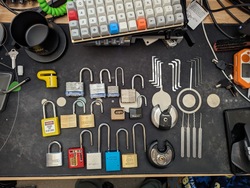Hey all, just wondering if anyone has any good self-hosted security cam recs? Have plenty of space and server options, and next big thing on my list is to get rid of my battery cloud cams. They have worked well enough I guess for a few years, but really pretty slow and limited, wondering if anyone has experience with any self-hosted solutions, preferably with similar features ie: motion detection, app/webapp, maybe battery op?
Reolink cameras are self-hosted. You don’t have to have an account in their app, and nothing is synced to the cloud. It’s all stored locally. They’re expensive cameras by comparison, but a. they’re really high quality, and b. they’re not subsidized by subscription fees.
I tried to use Shinobi as my PVR for a while but dealt with a lot of usability and stability issues. Switching to Frigate has been much better. Configuration can be a bit difficult but it’s rock solid and really great. Plus the home assistant integration is top notch. I’ve had a lot of luck with Amcrest cameras and also managed to use a cheap Tapo camera within my setup.
This is maybe controversial, but I love the Ubiquiti security stuff. Cameras (interior and exterior) doorbells, etc, it’s all great. Pricey, but you get what you pay for.
And the data can stay local or be accessible via their services.
I chose to go local only, grabbed their UNVR and populated it with 4x 2TB drives and it has enough space to handle 7 cameras HD history for about a month.
I’ve experimented with ubiquiti cameras and for the most part I find them very overpriced for their quality point. They’re good cameras, but they’re not ONVIF compatible so if you want to get into their (super overpriced and limited) ecosystem you won’t be able to intermix other cameras easily.
A good example is their doorbell camera. It’s just not good. And they don’t have more than one model, so if you want a good one you’re buying something else, that won’t work in their software, so now you’re using two systems to watch your cameras.
I’m glad they work for you, but I don’t recommend getting into their camera ecosystem.
When I needed this I reached for whatever generic rtmp cameras were well rated. Blocked them from external access (including outgoing!) at the firewall level and used Zoneminder and some custom scripts to monitor.
Frigate + Reolink (or actually Frigate-approved cams)
Amcrest seems to be the cheapest and I have good experience with them and Frigate
Used them before, but you have to be kinda careful with Amcrest, every once in awhile they throw one out that is especially shitty to self host.
For non cloud cams, someone posted here a while back about thingno firmware, takes cheap cams off the cloud. Works great on a wyze cam and was a gamechanger for me. Sttrroonngglllyyy recommend
I had never heard of this so went looking. Super useful stuff here!
A link for anyone interested: https://thingino.com/
I see it supports many cameras, but you need to pull them apart and use a serial hookup to flash the firmware… but for the wyze cams and a few others you can flash them directly with an SD card.
I liked how cheap the wyze cams were but desperately wanted to get them offline. This was my silver bullet.
Oh thank god. This solves my problem of no good integrated cam hardware on the market that isn’t cloudified or a huge security hole.
@empireOfLove2 @Windex007 Just keep them off the network. There is no reason for a security camera to have LAN access.
How you gonna get the video feed off an IP cam and onto your NVR without connecting it to your network?
You’re not seriously suggesting using old analog cameras in 2025, are you?
Maybe they mean main network? Lots of people seem to have a separate vlan with strict rules on what they can cobtact for IoT devices nowadays due to how poorly secured they are.
New to me & bookmarked. I am sure I have some crap lying around that this would work with.
Thank you!
Can we pin one of these posts? The same thing gets asked even few days and the answers don’t change nearly that frequently
I have a Reolink PoE camera. It works fine. As far as I can tell, it only uses the internet to check for updates and set the time, but I have it blocked off anyway. Home Assistant was actually causing it to check for updates, too, so that got disabled.
I don’t record, so I can’t help you there.
I will say that is a pain to get Home Assistant to display real-time video instead of a slide show.that’s weird i have some reolink cameras and they display fine through home assistant
you managed to get it in realtime though? may i ask how?
Eh? Shouldn’t it be real time already?
this is my configuration:
- camera_view: live type: picture-glance entities: [] camera_image: camera.cam_profile000_mainstream tap_action: action: noneI am using ONVIF integration for the camera.
Mine even play audio
I haven’t, that’s the problem. It seems like it’s possible, but I’ve given up trying for the moment.
I just checked out frigate, and I see it crutches on docker. Anything docker-free?
Frigate is popular.
I used to use ZoneMinder, it worked well, but you must be very familiar with onvif, primary/secondary channels, and key frames for it to work well.
I only switched to frigate because of the person/animal detection. It’s ok, but it does need some polish in a few areas like event retention, and it could stand some more approachable documentation.
Used Zoneminder for a 20 camera store CCTV setup and can confirm, it’s complicated but powerful. I wouldn’t use it for less than 4 cams.
The alternative I’d use personally is https://motion-project.github.io/ though. Doesn’t make much difference.
Dahua and Hikvision have great cameras but of course you shouldn’t trust them. Block them at the firewall. I bought mine a few years ago and preferred Hikvision for its better built in webserver for initial configuration.
On the hosting side you run Frigate, Zoneminder or BlueIris (Windows) to control the cameras and record their streams.
@Blue_Morpho @jabeez Huh I preferred Dahau. Thought the interface was nicer and the cameras low light looked way better.
For hardware, anything that can provide a local rtsp stream is a good place to start. I run cheap and cheerful mix of tapo, unbranded and homebrew esp32 cams. Offload the motion/object detection and alerts to something that can pull in the feeds, and isolate the cams to local network only.
WiFi usually ok, but at least hardwire the power to save future grief.
Using frigate to manage mine, which is running under Homeassistant - another project worth looking up.
A few images, featuring Freddie the visitor:



Tell me more about your homebrew esp32 cams, please!
Gladly. I’ll collate a few bits later - time for work.
Any cam with an rtsp stream is fine. Host frigate on your server point it to the cams you can get audio and video and object detection pretty easily. I also recommend taking an extra step and creating a firewall rule to block the cams’ inbound/outbound internet traffic.








